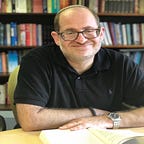#518: Forbidden Translations
יִשָּׂ֨א יְהֹוָ֤ה ׀ פָּנָיו֙ אֵלֶ֔יךָ וְיָשֵׂ֥ם לְךָ֖ שָׁלֽוֹם׃
יהוה bestow [divine] favor upon you and grant you peace!
Today, non-Hebrew speakers who want a translation of the Torah as it is read…
Gimme Some Torah #519
Today, non-Hebrew speakers who want a translation of the Torah as it is read in the synagogue need only move their eyes to the translation that appears on every page of the ḥumash. Ḥumashim are available in a wide variety of translations, with English, Spanish, Russian, French, and German being the most common.
But 1500 years ago, when the center of the Jewish world was in Baghdad, there were no printed books of any kind, let alone ḥumashim. Instead, a man known as the מתורגמן (meturgeman) translated the reading verse by verse so that the assembled Jews could hear the Torah in their native tongue of Aramaic.
These Aramaic translations are known collectively as the תרגום (Targum), and the most widely read Targum is that of a Roman convert by the name of Onkelos.
R. Asher Wassertheil (bio) points out that in the ancient manuscripts of Onkelos, there is no Aramaic translation of Num. 6:24–26, also known as Birkat Kohanim. He explains that these verses are in the Mishnah’s category of “neither read aloud nor…
